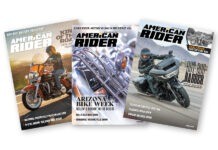What is it with Sportsters, anyway? The venerable XL, descending from the even more venerable side-valve W and K models, has been with us for over half a century now, with no end in sight. The only automotive icon that antecedes the Sporty is the Chevy Corvette, and even disregarding its roots, the “branches” on the X-engine family tree are without parallel in the annals of internal combustion. I’d also like to wax pedantic about all this nonsense regarding the XL being a “dirt bike” or “girl’s bike” or any of the other complete bull crap bandied about by the jealous and misinformed, but instead I’ll simply ignore that in favor of a bit of updating on its chronology and development from the starting point of the preface I wrote for my book, Sportster/Buell Engine Hop Up Guide, published nearly a decade ago.
“The first Superbike is still a super bike, though perhaps not as many folks recognize the fact as should. Since its birth back in 1957, the Sportster has been everywhere and done everything that a motorcycle possibly can. It has been successful at everything it’s ever tried and won every competition in which it could possibly be entered. It has been customized outrageously and hot-rodded mercilessly. It has survived and prospered while virtually all its contemporaries have faded into memory. It is the first and last of its kind. It is the machine against which all its competitors were, and in many cases are, measured. It has been cloned, imitated and envied for decades. It is loved for what it is, and liked in spite of what it is. It is unique. Counting its new incarnation as a Buell it has also come full circle. In that iteration it is as it was, America’s sportbike. Yet, it can be nearly all things to nearly all people. Touring bike, muscle bike, cruiser, sportbike, commuter bike, working bike—and more. It will never be perfect. It will always be desirable. It is a machine of fable and foible, yet the most honest and most accurate definition of “Motor” … “Cycle.” The many legends that exist, and will exist about this bike, serve its owners and its maker well. The truth serves better.

“When it first appeared it was the fastest motorcycle on the planet, inheriting the mantle from the fabulous Vincent. Journalist-testers of the time were driven to goggle-eyed, raving superlatives in their attempts to describe the feeling. “The Sportster will grow hair on your chest, and if you already have hair on your chest… it will part it down the middle.” Today, people tend to forget that nearly 50 years ago, with only moderate fiddling and fettling, the Iron Sportster could run 12-second quarter miles.
“Following in those fabled footsteps, the Evolution 1200 Sportster engine, in the emission-regulated, performance-hampered 21st century, will still run low 13s… bone stock. In absolute terms, that’s still plenty fast, with more (often much more) to be had for the asking. In the car world, only the most expensive and exotic types can even come close. And, V-Rods not withstanding, the Sportster has always been the Harley with the performance “rep.” Evolution 1200s can, and often do, make more power than the traditional air-cooled Big Twin motors. And more torque than anything else its size. This fact, coupled with its relatively light weight, means a sharp big-bore “X” can still run with the big dogs—and often lead the pack, to boot. The Sportster chassis works well enough to be road raced and dirt tracked virtually unmodified. The Buell chassis just kicks the whole concept of street performance and chassis competence up a notch or two.
Whether in a Sportster or Buell chassis the “X” engine is the only “quadruple under-head cam” engine in production anywhere in the world. This unique feature, more than any other, has allowed tuners to tailor the breathing characteristics of each valve. This spawned the greatest “breather” in dirt track racing history—the XR750. Not to mention the rare street version, the XR1000. An X-engine’s unit construction (engine and transmission in the same set of cases) makes for a strong, bullet-proof tool that weighs very little for its displacement. It’s a dead simple powerplant to work on as well. The fact that it has continued to evolve (sorry, that just slipped out) over all these years, means it holds no dark secrets and bears no hidden malice. As engines go, it is a known and workable commodity, much like the equally venerable and amazing small-block Chevy.
“The latest improvements, like moving the alternator out from behind the clutch, adding a gear to the tranny, and a derby cover on the primary are just the beginning. Consider, also, the one-piece no-leak pushrod tubes, hydraulic lifters good to over 7000 rpm, belt drive and a myriad of details I’ve probably forgotten to list. Taken together, all these improvements make the newest “X” engines the most desirable ever. In many ways they are vastly preferable to the “F” engines. And, if water jackets and “engine management” aren’t your cup of tea, perhaps even a better engine than the VRSC over the long run.
“If you doubt it, pay close attention to the tricks Eric Buell has conjured up for the venerable “X” engine—let alone Buell’s state-of-the-art chassis. The Firebolt represents a lot more than a trick frame holding a traditional (albeit hot-rodded) Evo XL engine. Look closely and you’ll see that almost everything about the Firebolt version of the powerplant is somehow different no matter how much the concept remains the same. From the beginning, Buell versions of the Sportster engine were hotter, tricker and really responsible for the resurgence of interest in the performance potential of the “X” engine.
“For the record—1200cc Buell engines differ from 1200cc Sportster engines in several major ways we’ll get into in detail in these pages. For now, the “Cliff Notes” would read something like this:
• High-flow heads
• Lighter flywheels
• Hotter cams
• High performance exhaust
“The 984cc Buell Firebolt engine differentiates even further. In fact, it is unique, with virtually no interchangeability of major components with its older cousins. The notable differences are:
• Short 3.15-inch stroke (in fact, the only “X” engine without a 3.81-inch stroke)
• Even lighter flywheels
• Shallow chamber heads with unique valve sizes
• Plastic pushrod covers
• Redesigned primary cover and cam cover
• Revised engine oiling system
• Fuel injected with “down draft” intake manifolding
• Special cams set
“Put another way—there are very few parts left that any XL or early Buell owner would recognize and the only thing left from the original Sportster is the primary chain. We’ve come a long, long way.
“What I don’t understand is why the “X” engine stuff doesn’t outsell the Big Twins.

“A modern Sportster motor has better-flowing heads, superior valve train geometry, more potential and greater durability. Since it’s better to build and cheaper to buy, it ought to be more popular. The engine/chassis combination is stiffer, stronger, lighter and better in handling, not even counting the Buell. What gives?
“Maybe it’s because The Motor Company simply hasn’t lavished the time, money and marketing on Sportsters that it has on the Big Twins. When you consider the chassis options available for the Big Twin buyer it becomes a little clearer. In spite of the hole in H-D’s price range between the point where the 1200 XL leaves off and the Super Glide starts, there are no Softail Sportsters. We don’t have any rubber-mount Sportsters (not counting the Buell, which as good as it is, isn’t exactly a mainstream-type “hog”), whereas there are three for Big Twins. Sportsters get no optional “fat” tanks or fenders either, as do the Big Twin models. There is nothing like a Springer XL, or a Wide Glide option. About all Sportster lovers get to pick out from the factory are color and displacement. Other trendy, modern motorcycles as good as Honda’s VFR, Kawasaki’s Ninja, Suzuki’s GSXR or Yamaha’s R1, to name but a contemporary few, only sell in relatively small numbers most years. Yet, H-D sells tens of thousands of supposedly “low-tech” Sportsters every year. This is crazy. Imagine what the factory could do if they tried!
“Well, maybe they are trying. The dedicated Sportster assembly line they created a few years ago in Kansas City can’t be a sheer coincidence, can it? Perhaps the prospect of forthcoming counter-balanced or rubber-mounted X-engined models (and who knows what from Eric Buell) isn’t far-fetched, after all. It sure is tantalizing. Especially considering that they could probably be priced in the $8,000–$11,000 range. I believe there’s a lot more to the Sportster/Buell future. Fifty years from now we’ll have more legends—and better truths. But that’s then, this is here and now.”
Well… “here and now” is already 10 years ago, as this is written. One hell of a lot has changed and—Yes!—there are more legends and truths! My expectation of vibration control has been a reality since 2004. Fuel injection is all there is. Big tires, high bars and small tanks are trending. Though Buell is tragically absent, with the arrival of the XR1200 there is another choice of chassis and the Sportster “family” is selling better than ever!
Be that as it may—the undercurrents and occasional eddy in this ongoing torrent of X-engine machines is what intrigues me most. Successful as it has been all this time, the Sportster saga has had more than its fair share of hits, misses and mysteries along the way. In the next few columns I intend to revisit some of the most fascinating… bike by bike.
See you next month…


















